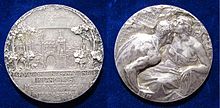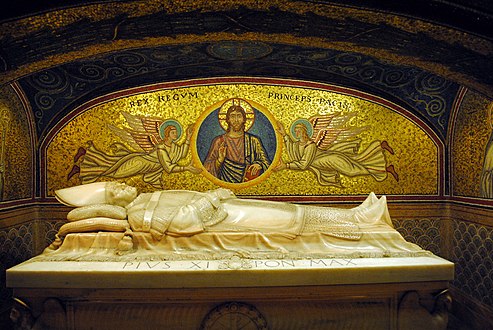Giannino Castiglioni
Giannino Castiglioni | |
|---|---|
 In his workshop, circa 1925, working on the sculptures for the Palacio Legislativo of Montevideo, Uruguay | |
| Born | 4 May 1884 Milan, Italy |
| Died | 27 August 1971 (aged 87) Lierna, Italy |
| Nationality | Italian |
| Education | Accademia di Belle Arti di Brera |
| Known for | sculpture, medals |
| Movement | Art Nouveau |
Giannino Castiglioni (4 May 1884 – 27 August 1971) was an Italian sculptor and medallist. He worked mostly in monumental and funerary sculpture; his style was representational, and far from the modernist and avant-garde trends of the early twentieth century.[1]
Life[]

Giannino Castiglioni was born on 4 May 1884 in Milan, the son of Giacomo Castiglioni and Piera Bergamaschi. His father was director of the Stefano Johnson mint in that city.[2]
Castiglioni studied sculpture under Enrico Butti at the Accademia di Belle Arti di Brera in Milan. He first exhibited at the Milan International Exhibition in 1906, where he showed medals, a plaster statue and a painting.[2] He married Livia Bolla, with whom he had three children: Livio (b. 1911), Pier Giacomo (b. 1913) and Achille (b. 1918). He opened a large studio on the Corso di Porta Nuova.[1]
In 1927 Castiglioni opened a second studio at his house in Lierna, on Lake Como. He died in Lierna on 27 August 1971.[2]
Work[]
From 1922 until 1928 Castiglioni worked on the plaster casts for friezes and monumental sculptures for the Palacio Legislativo of Montevideo, Uruguay; these were shipped to Uruguay, and the bronze or marble sculptures were made there. In the Fascist era he worked on sculptures for war cemeteries and monuments to the dead of the First World War, including: the military memorial of Monte Grappa (1935) in the Veneto; the (1937) in the comune of Paluzza, Udine; the military ossuary of Caporetto, now Kobarid, Slovenia; and the war memorial of Redipuglia (1938) in the province of Gorizia.[2] In 1941 he made the tomb of Pope Pius XI in the Vatican Grottoes.[3]
Reception[]
Castiglioni won the competition for the prize medal at the Milan International Exhibition in 1906. In 1922 he won the international competition to provide sculptures for the Palacio Legislativo of Montevideo.[2] He left more than three hundred of his preparatory plaster casts to the comune of Lierna; a museum is to house them is under construction.[4]
El trabajo, bronze, Palacio Legislativo, Montevideo, Uruguay

Tomb of Pius XI, St. Peter's, Rome
References[]
| Wikimedia Commons has media related to Giannino Castiglioni. |
- ^ Jump up to: a b Carlo Livio Castiglioni (2007). Lo "Studio Castiglioni" – Una storia lunga un secolo (in Italian). Fondazione Achille Castiglioni. Archived 2 January 2014.
- ^ Jump up to: a b c d e Giovanna Rosso Del Brenna (1979). Castiglioni, Giannino (in Italian). Dizionario Biografico degli Italiani, Volume 22. Rome: Istituto dell'Enciclopedia Italiana. Retrieved 31 December 2013
- ^ Chiara Vanzetto (29 March 2016). Una monografia per Giannino Castiglioni, genio del fare milanese (in Italian). Corriere della Sera. Accessed August 2020.
- ^ Marco Roncalli (31 January 2019). "Il leone di Desio": ottant'anni fa la morte di Pio XI, un Papa tra guerre e totalitarismi (in Italian). La Stampa. Accessed August 2020.
- 1884 births
- 1971 deaths
- Artists from Milan
- People from Lierna
- 20th-century Italian sculptors
- 20th-century male artists
- Italian male sculptors
- 20th-century Italian painters
- Italian male painters
- Art Nouveau medallists
- Italian medallists


